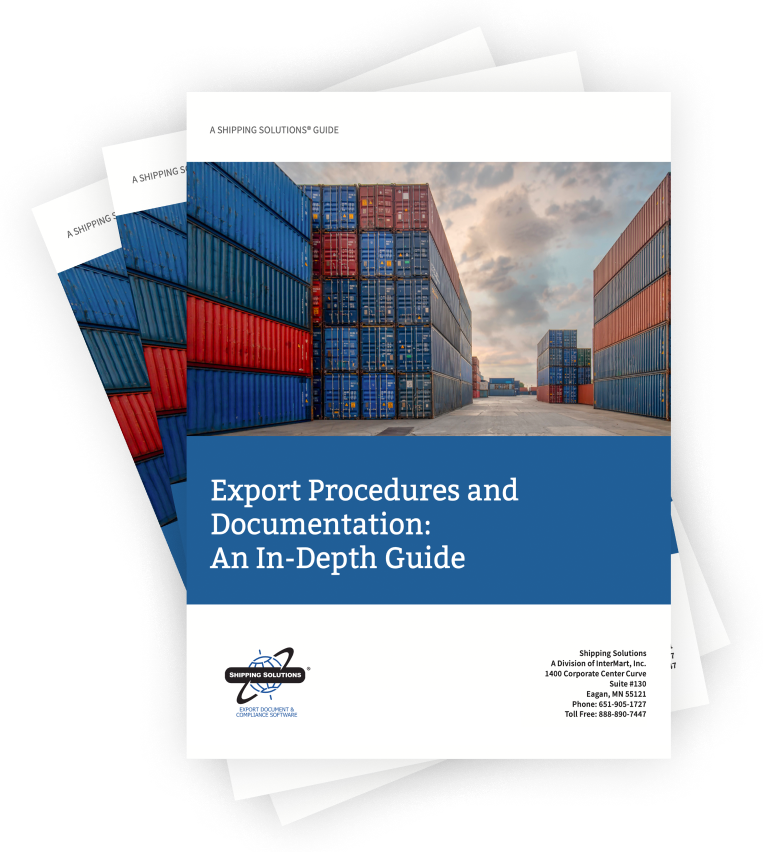The International Trade Blog International Sales & Marketing
Exporting to Canada: What You Need to Know
On: November 27, 2023 | By:  David Noah |
13 min. read
David Noah |
13 min. read

As our neighbor to the north, Canada is often the first place many U.S. exporters look to share their goods—and for good reason! A shared language, shared culture and excellent economic relationship with Canada make doing business there appealing to new and established exporters.
In this article, I’ll look at the history of U.S. trade with Canada; how the USMCA has altered trade with Canada; the process of exporting to Canada, including documentation and compliance requirements; and the benefits and considerations for U.S. companies looking to break into the Canadian market.
Facts and Figures on Trade and Exporting to Canada
Canada and the United States enjoy the world’s largest and most comprehensive trading relationship, which supports millions of jobs in both countries and constitutes a $1.7 trillion bilateral trade and investment relationship. The countries have economically and technologically developed in parallel. In most industry sectors, Canada is a highly receptive, open and transparent market for U.S. products and services, with Canadians spending more than 60% of their disposable income on U.S. goods and services. (ITA)
In February 2025, the Trump Administration proposed a 25% tariff on Canadian imports (which was walked back shortly thereafter). At this point, the current administration is pausing the proposed tariff—only time will tell what next steps will be taken by either country.
So what does the Canadian trade relationship with the U.S. look like today? In 2024, exports were $349.36 billion and imports were $412.695 billion. (Census Bureau)
The USMCA and Exporting to Canada
In 2020, NAFTA was replaced by the United States-Mexico-Canada Agreement (USMCA). As a result, companies that used the benefits of NAFTA when exporting to Canada had to review their products to make sure they qualified under the terms of USMCA. While many products didn’t have significant changes, certain key industries in Canada, like agriculture, did have significant changes.
The USMCA modernized and balanced U.S. trade relations with Canada (and Mexico) and reduced incentives to outsource by providing labor and environmental protections, innovative rules of origin and revised investment provisions. The Agreement also brought labor and environmental obligations into the core text and made them fully enforceable.
However, with a new U.S. administration, the future of USMCA remains uncertain. While the agreement is still in force, any shifts in trade policy or political priorities could lead to changes in its implementation or potential renegotiation. This is particularly relevant as the agreement is set for its first formal review in 2026, when all three countries will have the opportunity to assess its impact and propose modifications. Businesses that rely on USMCA’s provisions should stay informed and be prepared for possible adjustments in the coming years.
Here are some of the highlights of this agreement, as it stands today:
- Under USMCA, Canada and Mexico agreed to strong enforcement provisions against counterfeiting and piracy, ensuring protection of trade secrets and ex officio authority for law enforcement officials to stop suspected in-transit counterfeit goods.
- USMCA contains the strongest disciplines on digital trade of any international trade agreement, including rules to ensure that data can be transferred cross-border and minimizing limits on where data can be stored and processed.
- USMCA increased access for U.S. dairy and poultry farmers to the Canadian market and eliminated its discriminatory grading of U.S. wheat.
- USMCA committed to ensuring that British Columbia eliminates discriminatory treatment of U.S.-origin wine in grocery stores and includes new non-discrimination and transparency commitments regarding the sale and distribution of alcoholic beverages.
- USMCA increases the de minimis rule for exports to Canada (up to $150 CAD) and Mexico ($117 USD) to allow goods up to that value to enter duty-free. This was intended to boost small e-commerce orders to those countries. The U.S. de minimis amount remained unchanged at $800, although the agreement allows the U.S. to match the de minimis amounts of the other two countries if it desires.
- To stimulate more North American auto production through updated automotive rules of origin, USMCA increased regional value content for passenger vehicles and light trucks from 62.5% to 75%, phased over three years.
USMCA also designated importers as the party to make the claim to the appropriate customs authority for preferential duty rates under the agreement based on certification that the goods qualify from the producer, exporter or importer. (NAFTA had designated the exporter as the party to make the claim.)
While there is no longer an official certificate of origin form, whichever party is certifying that the goods meet the rules of origin must provide, at minimum, certain data elements as outlined in the agreement to support the claim. That information can be provided on the invoice or on a separate attached document—a certification of origin. That document may be a hard copy or digital.
Exporting to Canada: The Challenges
Fortunately for exporters interested in exporting to Canada, there are few trade barriers to overcome. According to the ITA, challenges include:
- Notably, many exporters forget that Canada is, indeed, a different country that requires specific export procedures. As a result, they fail to follow export compliance regulations.
- U.S. exporters must understand differing provincial regulations, conduct due diligence on market potential and sales channels, comprehend labeling and packaging requirements and certification standards and customs procedures, and, in general, must educate themselves on unique industry matters relevant to selling their goods or services in Canada.
- Increasing competition in several sectors such as cosmetics, vitamins, electronics and home furnishings translates into a need for competitive pricing, provocative and imaginative marketing, and deep discounts for agents and distributors. Exporters should be prepared for Canada Customs documentation, bilingual labeling and packaging requirements, Canadian federal and provincial sales tax accounting, and, in some cases, should be aware of International Traffic in Arms Regulations (ITAR).
- Bidding for contracts can also be a challenge for U.S. exporters because of the requirements and security clearances. Bidders must be registered in Canada to bid and must fulfill all Canadian requirements to be awarded contracts (mandatory requirements are non-negotiable).
Rules and Regulations in Canada
As previously mentioned, deciphering Canadian rules and regulations for exporting can be frustrating in the least and, at worst, cause issues that force an exporter to stop trade with the country completely.
There are ways to combat these issues when exporting to Canada:
- Work closely with your local U.S. Commercial Service office. They will link you to offices in Canada that will help you establish your presence in Canada and assist you through difficulties you may face.
- Additionally, the U.S. Department of Commerce's Advocacy Center can help you with the early stages of your project.
- Find partners who have experience working with Canada. Your freight forwarder and banker should have documented experience working with the country.
Exporting to Canada: The Opportunities
The potential rewards of exporting to Canada likely far outweigh any challenges exporters may face. Exporters should identify and cultivate opportunities while building a strategy to minimize the risks.
The positive impacts of the USMCA mean that Canada may be a better option for exporting than other countries. The USMCA improves market access for U.S. companies in several important ways, specifically through intellectual property rights, digital trade, labor obligations, environmental obligations and automotive manufacturing.
Canada’s most promising sectors include the following:
- Aerospace and defense
- Agriculture
- Automotive
- Medical devices
- Renewable energy, including hydro, wind, solar, biomass, geothermal and marine energy
- Information technology
Export Assistance
The best thing about exploring the opportunities to export to Canada is knowing you don’t need to go it alone. You can rely on assistance from your in-country allies, including the U.S. Commercial Service office, trade missions, and chambers of commerce.
U.S. Commercial Service Offices
One of the first places to consider are your local and in-country U.S. Commercial Service offices. The Commercial Service in-country offices offer U.S. exporters business partners in Canada—boots on the ground in the country—and include representation by an agent, distributors or partners who can provide essential local knowledge and contacts that can be critical for your success. You can learn more about in-country offices in our article, Tapping into the U.S. Commercial Service's In-Country Offices.
District Export Councils (DECs)
DECs across the country can help exporters by supporting trade and services that strengthen individual companies, stimulate U.S. economic growth and create jobs. DEC members also serve as mentors to new exporters and can provide advice to smaller companies.
Sponsored by state and local trade offices as well as commercial service offices, trade missions are a great way to get introduced to and network with contacts. Check into them.
International Trade Administration (ITA)
The ITA is an excellent resource to help you combat trade problems. ITA staff are resident experts in advocating for U.S. businesses of all sizes. They customize their services to help solve your trade dilemmas as efficiently as possible. The ITA makes it easy to report a problem, allowing you to submit your report online.
Chambers of Commerce
Chambers of commerce may be a resource when exporting to Canada. You can learn more about various chambers and how they can help smooth the way for your export activities in our article, The Chamber of Commerce Role in Exporting.
Export Document Requirements for Canada
When exporting to Canada, documentation and procedures are still critical. According to the International Trade Administration, the most important document a U.S. exporter needs when exporting to Canada is the Canada Customs Invoice or a standard commercial invoice that includes all the required information.
Other documents you need to export to Canada will vary depending on your products, but they include:
- Bill of lading
- USMCA certification of origin
- Packing list
- Sales contract
- Proforma invoice
- Customs declaration
- Insurance policy
Export Compliance Issues When Exporting to Canada
It’s important to understand the regulations covering exports to Canada. You must be concerned with complying with export regulations no matter where you ship, but, fortunately, understanding regulations is easier to do than, say, if you were exporting to China.
This doesn’t mean you can take export compliance lightly. You need to understand what is required of you and what you risk if you don’t do your job in complying with those regulations.
Product Classification for Export Controls
The first step in ensuring export compliance is determining who has jurisdiction over your goods: the U.S. Department of Commerce under the Export Administration Regulations (EAR) or the State Department's Directorate of Defense Trade Controls (DDTC).
If your goods fall under the jurisdiction of the Commerce Department, which most products do, you must determine if your export requires authorization from the Bureau of Industry and Security (BIS, part of the Commerce Department). To do so you need to answer the following questions:
- What is the Export Control Classification Number (ECCN) of the item?
- Where is it going?
- Who is the end user?
- What is the end use?
There are three ways to classify your products for export controls: You can self-classify your products, submit a SNAP-R request for a ruling, or rely on the product vendor to provide the information. You can learn about that process in our article, Export Codes: ECCN vs. HS, HTS and Schedule B.
By classifying your product correctly, you’ll be protecting yourself from potential fines, penalties and even jail time.
Export License Determination
Next, companies must use the ECCN codes and reasons for control described above to determine whether or not there are any restrictions for exporting their products to specific countries. Once they know why their products are controlled, exporters should refer to the Commerce Country Chart in the EAR to determine if a license is required.
Although a relatively small percentage of all U.S. exports and re-exports require a BIS license, virtually all exports and many re-exports to embargoed destinations and countries designated as supporting terrorist activities require a license. Countries fitting that bill are Cuba, Iran and North Korea. Part 746 of the EAR describes embargoed destinations and refers to certain additional controls imposed by the Office of Foreign Assets Control (OFAC) of the Treasury Department.
The Shipping Solutions Professional export documentation and compliance software includes an Export Compliance Module that uses the ECCN code for your product(s) and the destination country to tell you if an export license is required. If indicated, you must apply to BIS for an export license through the online Simplified Network Application Process Redesign (SNAP-R) before you can export your products.
There are export license exceptions, like low-value or temporary exports, that allow you to export or re-export, under stated conditions, items subject to the Export Administration Regulations (EAR) that would otherwise require a license. These license exceptions cover items that fall under the jurisdiction of the Department of Commerce, not items controlled by the State Department or some other agency.
Deemed Exports
Surprise! You may be an exporter without even knowing it! Deemed exports, or the disclosure of information or services rather than an actual product, is an important issue to pay attention to when exporting. A deemed export occurs when technology or source code (except encryption and object source code, which is separately addressed in the EAR under 734.2(b)(9)), is released to a foreign national within the United States.
Sharing technology, reviewing blueprints, conducting tours of facilities, and other information disclosures are considered potential exports under the deemed export rule and should be handled accordingly. You can learn how to apply this principle here.
Restricted Party Screenings
Restricted party lists (also called denied party lists) are lists of organizations, companies or individuals that various U.S. agencies—and other foreign governments—have identified as parties that one can’t do business with.
There are several reasons why a person or company may be added to a restricted party list. For example, they may be a terrorist organization or affiliated with such an organization, they may have a history of corrupt business practices, or they may otherwise pose a threat to national security.
Restricted party screening (or denied party screening) refers to the process in which a company checks a potential customer or business partner against one or more of the restricted party lists to ensure they are not doing business with a restricted party.
The primary restricted party lists in the United States are published by the Department of Commerce, Department of State, and Department of Treasury. However, several other agencies produce lists as well. These agencies recommend that companies perform restricted party screening periodically and repeatedly throughout the movement of goods in the supply chain.
When exporting to Canada, it’s imperative you check every single restricted party list every time you export.
- Fines for export violations can reach up to $1 million per violation in criminal cases (Bureau of Industry and Security).
- Administrative cases can result in a penalty amounting to $250,000 or twice the value of the transaction, whichever is greater.
- Criminal violators may be sentenced to prison for up to 20 years, and administrative penalties may include denial of export privileges.
Export Documentation and Compliance Software
If you’re considering exporting to Canada, Shipping Solutions export documentation software can help you quickly create the necessary documents and stay compliant with export regulations. Register for a free demo of the Shipping Solutions software to see how it can revolutionize the way you’re currently creating your export paperwork.
This is one in a series of articles exploring exporting to specific countries across the globe—we previously featured ASEAN countries, Australia, Belgium, Brazil, China, the EU, France, Germany, India, Israel, Japan, Mexico, the Netherlands, Russia, Singapore, South Korea, Taiwan and the United Kingdom.
Like what you read? Join thousands of exporters and importers and subscribe to the International Trade Blog to get the latest news and tips for exporters and importers delivered to your inbox.
This article was first published in October 2017 and has been updated to include current information, links and formatting.

About the Author: David Noah
As president of Shipping Solutions, I've helped thousands of exporters more efficiently create accurate export documents and stay compliant with import-export regulations. Our Shipping Solutions software eliminates redundant data entry, which allows you to create your export paperwork up to five-times faster than using templates and reduces the chances of making the types of errors that could slow down your shipments and make it more difficult to get paid. I frequently write and speak on export documentation, regulations and compliance issues.





